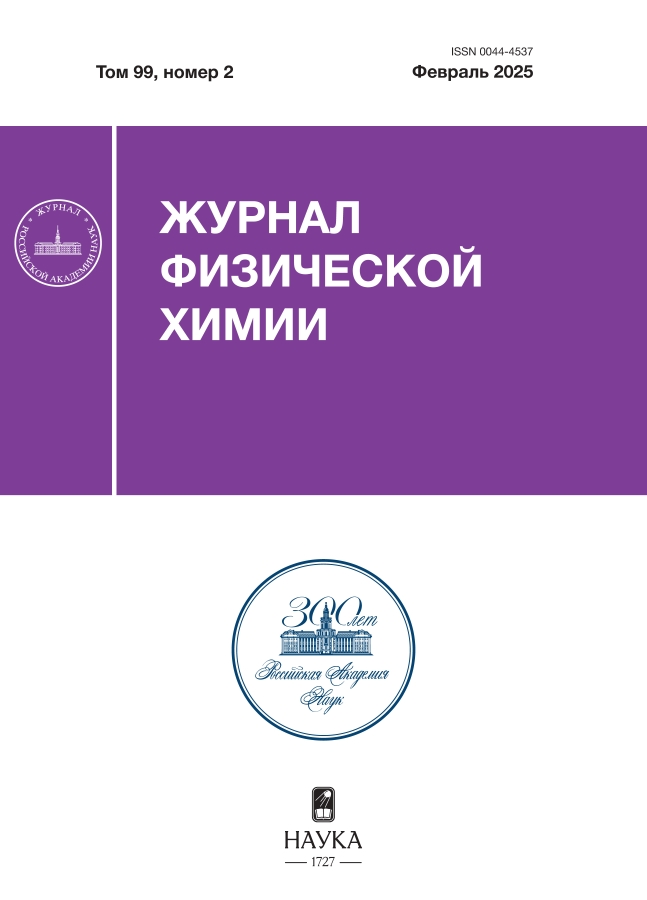Thermochemistry of dissolution of tetra-4-carboxyphthalocyanine hydroxoaluminum in aqueous KOH solutions at 298.15 K
- Авторлар: Krutov P.D.1, Maizlish V.E.1, Krutova O.N.1, Usacheva T.R.1, Bazanov M.I.1, Chislov M.V.2, Kiptikova E.E.1
-
Мекемелер:
- Ivanovo State University of Chemistry and Technology
- Thermogravimetric and Calorimetric Research Methods Resource Center
- Шығарылым: Том 99, № 2 (2025)
- Беттер: 195-199
- Бөлім: CHEMICAL THERMODYNAMICS AND THERMOCHEMISTRY
- ##submission.dateSubmitted##: 19.06.2025
- ##submission.datePublished##: 20.05.2025
- URL: https://hum-ecol.ru/0044-4537/article/view/685267
- DOI: https://doi.org/10.31857/S0044453725020032
- EDN: https://elibrary.ru/DELELK
- ID: 685267
Дәйексөз келтіру
Аннотация
Hydroxoaluminum tetra-4-carboxyphthalocyanine is studied. Heat effects of dissolution of crystalline phthalocyanine in aqueous solutions of different concentration of KOH at 298.15K are determined by the direct calorimetric method. The values of the heat effects of the stepwise dissociation of AlOHРс(4-COOH)4 are calculated using the HEAT computer program. The enthalpies of combustion of the compound involved are found using IKA C6000 isoperibolic calorimeter (the bomb calorimetry method); they are necessary for calculation of standard enthalpies of formation of AlOHРс(4-COOH)4 and products of its dissociation in an aqueous solution.
Негізгі сөздер
Толық мәтін
Авторлар туралы
P. Krutov
Ivanovo State University of Chemistry and Technology
Хат алмасуға жауапты Автор.
Email: kdvkonkpd@yandex.ru
Ресей, Ivanovo
V. Maizlish
Ivanovo State University of Chemistry and Technology
Email: kdvkonkpd@yandex.ru
Ресей, Ivanovo
O. Krutova
Ivanovo State University of Chemistry and Technology
Email: kdvkonkpd@yandex.ru
Ресей, Ivanovo
T. Usacheva
Ivanovo State University of Chemistry and Technology
Email: kdvkonkpd@yandex.ru
Ресей, Ivanovo
M. Bazanov
Ivanovo State University of Chemistry and Technology
Email: kdvkonkpd@yandex.ru
Ресей, Ivanovo
M. Chislov
Thermogravimetric and Calorimetric Research Methods Resource Center
Email: kdvkonkpd@yandex.ru
Ресей, Scientific Park of St. Petersburg State University, St. Petersburg
E. Kiptikova
Ivanovo State University of Chemistry and Technology
Email: kdvkonkpd@yandex.ru
Ресей, Ivanovo
Әдебиет тізімі
- Wöhrle D., Schnurpfeil G., Makarov S.G. et al. // Макрогетероциклы. 2012. № 5 (3). С. 191. https://doi.org/10.6060/mhc2012.120990w
- Зуев К.В., Перевалов В.П., Винокуров Е.Г. и др. // Макрогетероциклы. 2016. Т. 9. № 3. С. 250. https://doi.org/10.6060/mhc160212z
- Лебедева Н.Ш., Юрина Е.С., Губарев Ю.А., Майзлиш В.Е. // Биоорганическая химия. 2016. Т. 42. № 1. С. 36.
- Xie D., Pan W., Jiang Y.D., Li Y.R. // Materials Letters. 2003. V. 57. P. 2395. https://doi.org/10.1016/S0167-577X(02)01242-9
- Lam M.K., Kwok K.L., Tse S.C. et al. // Optical Materials. 2006. V. 28. P. 709–713.
- Koifman O.I. // Macroheterocycles. 2020. V. 13(4). P. 311. https://doi.org/10.6060/mhc200814k
- Березин Д.Б., Макаров В.В., Знойко С.А. и др. // Менделеевские сообщения. 2020. T. 30. P. 621–623. https://doi.org/10.1016/j.mencom.2020.09.023
- Шапошников Г.П., Кулинич В.П., Майзлиш В.Е. // Модифицированные фталоцианины и их структурные аналоги. Монография / Под ред. О.И. Койфмана. М.: КРАСАНД. 2012. 480 с.
- Карпова С.Г., Ольхов А.А., Кривандин А.В. и др. // Высокомолекуляр. соединения. Сер. А. 2019. Т. 61. № 1. С. 67.
- Градова М.А., Жданова К.А., Брагина Н.А. и др. // Изв. АН. Сер. хим. 2015. № 4. С. 806.
- Lobanov A.V., Nevrova O.V., Ilatovskii V.A. et al. // Macroheterocycles. 2011. V. 4. № 2. P. 132.
- Чудинов А.В., Румянцева В.Д., Лобанов А.В. и др. // Биоорган. химия. 2004. Т. 30. № 1. С. 99.
- Данилова Е.А., Галанин Н.Е., Исляйкин М.К. и др. // Изв. вузов. Химия и хим. технология. 2023. Т. 66. Вып. 7. С. 111. https://doi.org/10.6060/ivkkt.20236607.6826j
- Крутова О.Н., Майзлиш В.Е., Лыткин А.И. и др. // Журн. физ. химии. 2023.Т. 97. № 2. С. 199. https://doi.org/10.31857/S004445372302011
- Крутова О.Н., Майзлиш В.Е., Черников В.В. и др. // Журн. физ. химии. 2023. Т. 97. № 6. С. 794. https://doi.org/10.31857/S0044453723060134
- Lytkin A.I., Chernikov V.V., Krutova O.N., Skvortsov I.A. // J. Therm. Anal. Calorim. 2017. T. 130. P. 457. https://doi.org/10.1007/s10973017-6134-6
- Лыткин А.И., Черников В.В., Крутова О.Н. и др. // Изв. высших учебных заведений. Серия “Химия и химическая технология”. 2019. Вып. 62. № 8. С. 81. https://doi.org/10.6060/ivkkt.20196208.5911
- Wadsö I., Goldberg R.N. // Pure Appl. Chem. 2001. T. 73. P. 1625. https://doi.org/10.1351/pac200173101625
- Usacheva T.R., Krutova O.N., Batov D.V. et al. // J. of Thermal Analysis and Calorimetry. https://doi.org/10.1007/s10973-024-13085-9
- Волков А.В., Платоночева О.Ю., Градусов В.Б., Крутова О.Н. // Изв. вузов. Химия и хим. технология. 2009. Т. 52. Вып. 4. С. 7.
- Александров Ю.И., Олейник Б.Н., Усвяцева Т.Р. // Тр. метрологических институтов СССР. М. – Л.: Изд-во стандартов, 1971. В. 29 (189). С. 155.
- Термические константы веществ / Спр. под ред. В.П. Глушко. Вып. III. М.: ВИНИТИ, 1965–1971.
- Васильев В.П. Термодинамические свойства растворов электролитов. М.: Наука, 1982. 262 с.
- Tyuninaa E.Yu., Krutova O.N., Lytkin A.I. // Thermochimica Acta. 2020. T. 690. P. 178704. https://doi.org/10.1016/j.tca.2020.178704
- Бородин В.А., Васильев В.П., Козловский Е.В. // Математические задачи химической термодинамики. Новосибирск: Наука, 1985. С. 219.
Қосымша файлдар











